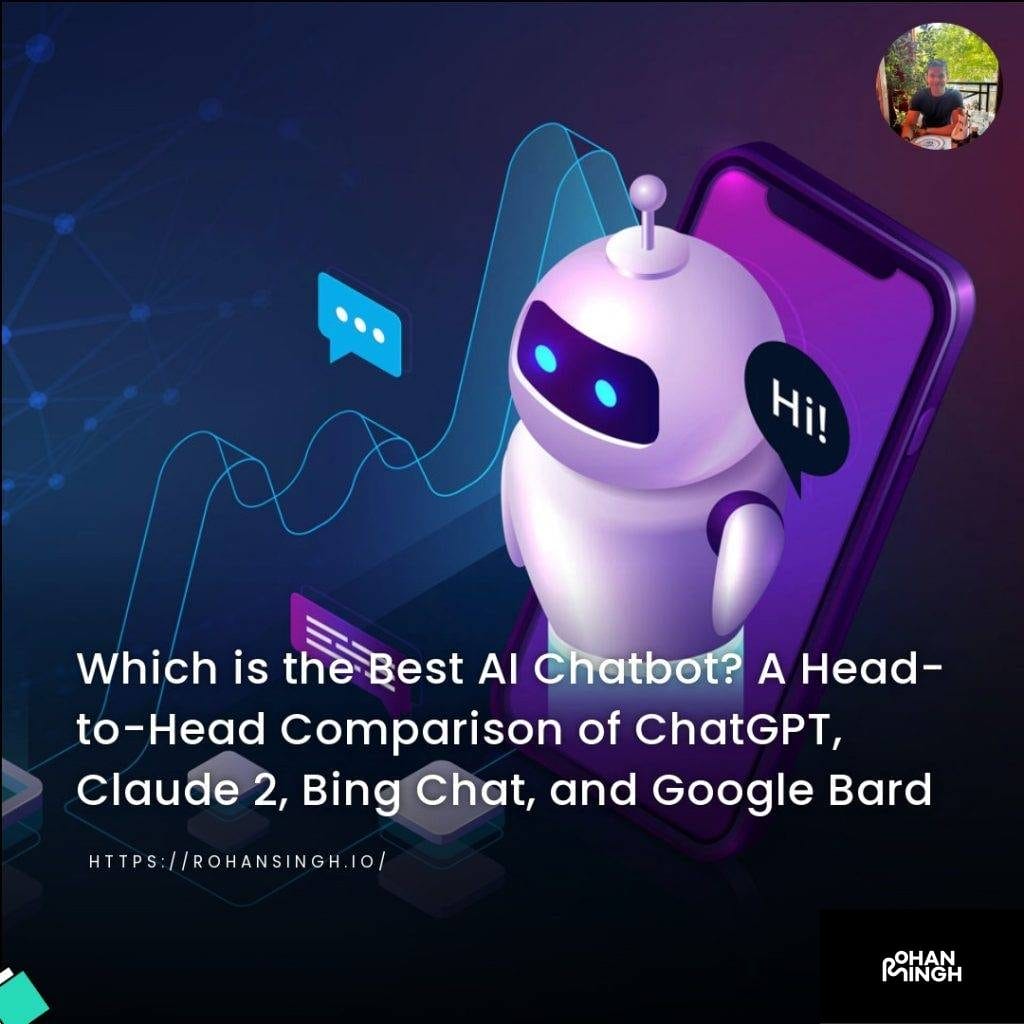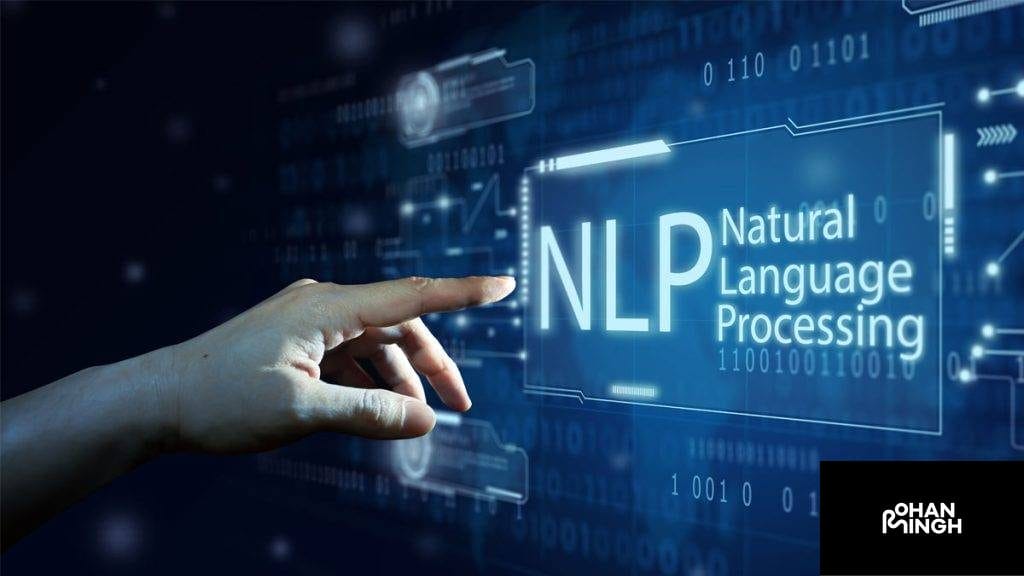Which is the Best AI Chatbot? A Head-to-Head Comparison of ChatGPT, Claude 2, Bing Chat, and Google Bard

What is an AI Chatbot?
An AI chatbot is a powerful tool powered by artificial intelligence and natural language processing that enables businesses and individuals to engage in human-like conversations with users. These chatbots are designed to understand and respond to user queries, providing relevant information and assistance in real-time. AI chatbots can be integrated into various platforms such as websites, messaging apps, and social media platforms, making them a versatile solution for customer support, lead generation, and increasing engagement. With the ability to handle a wide range of queries and provide accurate answers, AI chatbots offer an efficient and scalable way to enhance user experience and streamline communication processes. Businesses can leverage the capabilities of AI chatbots to provide personalized and instant support, ultimately improving customer satisfaction and driving business growth.
Table of Contents
ToggleOverview of Claude 2, Bing Chat, and Google Bard
Claude 2, Bing Chat, and Google Bard are all AI-powered chatbots that belong to the chatbot arena. These language models are designed to provide answers to questions and engage in conversations with users using natural language processing.
Claude 2 is the successor to Claude 1.3, developed by a team in San Francisco led by Jan Leike. It utilizes a wide range of data and machine learning techniques to generate responses that are more human-like and contextually accurate. Claude 2’s main strength lies in its ability to handle complex questions and provide detailed and informative answers.
Bing Chat, developed by Bing AI, is an AI chatbot that integrates with the Bing search engine. It is known for its efficient search capabilities and its ability to provide concise and accurate answers to user queries. Bing Chat also excels in generating follow-up questions to better understand user intent and provide relevant information.
Google Bard AI, on the other hand, is Google’s take on an AI-powered chatbot. It leverages the power of deep learning and natural language processing to comprehend and respond to a wide range of queries. Google Bard AI is known for its impressive ability to generate contextually aware and relevant responses.
In conclusion, Claude 2, Bing Chat, and Google Bard are all language models that utilize artificial intelligence to provide answers to user queries. Each chatbot has its own unique features and strengths, making them suitable for different use cases. Whether it’s handling complex questions, efficient search capabilities, or contextually aware responses, these AI chatbots offer valuable assistance in the realm of human language understanding.
Let's talk about your future project!
Eager to collaborate on your upcoming endeavor? Let's explore and ignite the potential of your next big idea, shaping a promising future together!
Features of Claude 2
As an AI Marketing Expert, I would like to introduce you to the features of Claude 2, an advanced language model developed by a team in San Francisco led by Jan Leike. Claude 2 builds upon its predecessor, Claude 1.3, and offers a range of impressive capabilities that make it a top contender in the AI chatbot arena. With a focus on handling complex questions and providing detailed answers, Claude 2 utilizes a wide range of data and machine learning techniques to generate responses that are more human-like and contextually accurate. Its ability to comprehend and respond to a variety of queries sets it apart, making it an excellent choice for users seeking a chatbot that can engage in meaningful and informative conversations. With its advanced natural language processing capabilities and efficient handling of complex questions, Claude 2 stands as one of the best AI chatbots available today.

Natural Language Understanding (NLU)
Natural Language Understanding (NLU) is a vital component in the development of AI chatbots. It refers to the capability of chatbots to comprehend and interpret human language effectively. NLU plays a significant role in improving the accuracy of responses and the overall performance of AI chatbots such as Claude 2, Bing Chat, and Google Bard.
There are two types of models used in NLU – generative and discriminative models. Generative models focus on understanding the underlying structure of language and are trained to generate text based on probability distributions. Discriminative models, on the other hand, learn the boundaries between different types of language inputs.
NLU enables chatbots to understand the intent behind user queries and generate appropriate responses. By utilizing deep learning techniques and natural language processing algorithms, NLU helps chatbots analyze and interpret user input effectively. This enhances their ability to provide accurate information and engage in meaningful conversations with users.
In the case of Claude 2, Bing Chat, and Google Bard, NLU plays a crucial role in improving their performance. It allows these chatbots to understand and respond to a wide range of user queries, even complex ones. By recognizing context, handling follow-up questions, and providing relevant answers, NLU ensures a seamless user experience.
In conclusion, NLU is a critical aspect of AI chatbots, allowing them to comprehend and interpret human language. By leveraging generative and discriminative models, chatbots like Claude 2, Bing Chat, and Google Bard are empowered to provide accurate information and engage in meaningful conversations with users.
Follow-up Questions
Follow-up questions in AI chatbots play a crucial role in enhancing the conversational experience and provide more accurate and personalized responses to users. When a user poses a question or makes a query, a chatbot equipped with follow-up question capabilities can gather additional information to better understand the user’s intent and context.
By asking follow-up questions, chatbots can dig deeper into a user’s query, seeking clarification or additional details. This interaction allows the chatbot to gather more information, enabling it to provide more accurate and relevant responses. For example, if a user asks, “What are the best hotels in San Francisco?”, a chatbot can follow up with a question like, “What is your budget range?” or “Are you looking for a specific location?”
Moreover, follow-up questions enable chatbots to maintain a coherent and dynamic conversation by considering the context of previous interactions. They can refer back to previous queries or responses to deliver more personalized answers. This contextual understanding ensures that the chatbot’s responses align with the ongoing conversation, leading to a more natural and engaging user experience.
In summary, follow-up questions empower AI chatbots to gather information, provide accurate responses, and personalize interactions. Leveraging this conversational technique, chatbots can deliver a more tailored experience, making them invaluable tools in various applications, such as customer support, virtual assistants, and information retrieval.
Text-to-speech Capabilities
Text-to-speech capabilities have become an integral feature in AI-powered chatbots like Claude 2, Bing Chat, and Google Bard. These advanced chatbots excel at converting written text into spoken words, enhancing the overall user experience.
By incorporating text-to-speech capabilities, these chatbots can provide a more interactive and accessible user interface. Users can simply type their queries and receive responses in a natural and human-like voice, eliminating the need to read lengthy responses or search for information visually. This feature is particularly beneficial for users with visual impairments or those who prefer auditory information consumption.
Moreover, text-to-speech enhances the chatbot’s ability to engage users in dynamic and real-time conversations. The spoken responses make the interactions more conversational and personalized, enabling the chatbot to deliver information in a more engaging manner.
The significance of text-to-speech capabilities in AI chatbots cannot be understated. It empowers these chatbots to cater to a wider audience and ensures that the user experience is seamless, regardless of individual preferences or accessibility needs. As the demand for more inclusive and interactive chatbot experiences grows, chatbots with text-to-speech capabilities will undoubtedly dominate the competitive AI chatbot arena.
In conclusion, the incorporation of text-to-speech capabilities in AI chatbots like Claude 2, Bing Chat, and Google Bard elevates the user experience by converting written text into spoken words, providing a more interactive and accessible platform for users.

Automated Answer Generation
Automated answer generation is a fundamental feature in AI chatbots like Claude 2, Bing Chat, and Google Bard. These chatbots utilize natural language processing algorithms to analyze user queries and generate accurate and relevant responses in real-time.
Using advanced machine learning techniques, these chatbots are trained on vast amounts of data to understand and interpret the meaning behind user queries. The chatbots use natural language processing algorithms to break down the query, extract key information, and identify the user’s intent.
Next, the chatbots search their knowledge base, which comprises a wide range of pre-existing information, to find the most appropriate response. This can include answers to common queries or information from trusted sources.
To ensure the accuracy of the responses, these chatbots continuously learn and adapt. They leverage deep learning algorithms to analyze user feedback and update their knowledge base accordingly. This iterative learning process improves the chatbot’s ability to generate accurate and relevant answers over time.
Automated answer generation in AI chatbots like Claude 2, Bing Chat, and Google Bard is a powerful tool that streamlines information retrieval and provides users with immediate answers. As these chatbots continue to advance, their ability to generate accurate and relevant responses will only improve, making them the best AI chatbot choice for businesses and individuals alike.
Contextual Awareness and Adaptive Learning
In the realm of AI chatbots, Contextual Awareness and Adaptive Learning are essential capabilities that enable chatbots to provide more accurate and relevant responses to user queries. By leveraging these abilities, chatbots continually enhance their performance over time based on user interactions.
Adaptive Learning allows chatbots to learn and improve through an iterative process. By analyzing user feedback and interactions, chatbots can identify patterns, understand user preferences, and update their knowledge base accordingly. This iterative learning process empowers chatbots to generate more accurate and contextually appropriate responses in the future.
Contextual Awareness is another important aspect of chatbot functionality. It enables chatbots to understand the context of a conversation and adjust their responses accordingly. Chatbots can analyze not only the current query but also the preceding conversation or user history to derive meaning and provide relevant answers based on that context. This contextual understanding enhances the chatbot’s ability to dynamically adapt and deliver personalized responses that align with the user’s specific needs.
An example of contextual awareness in AI chatbots is the ability to handle follow-up questions. When a user asks a series of related questions, the chatbot can understand the context of the previous queries and provide seamless and coherent replies. This contextual understanding eliminates the need for users to repeat information and creates a more natural and engaging conversational experience.
By combining Contextual Awareness and Adaptive Learning, chatbots can continuously improve their performance, resulting in more accurate, relevant, and personalized responses for users. These capabilities enhance user satisfaction and make chatbots valuable tools in various industries such as customer support, e-commerce, and information retrieval.
Dialog Management System (DMS)
The Dialog Management System (DMS) plays a crucial role in AI chatbots by effectively managing and guiding conversations between users and the chatbot. It acts as the brain behind the bot, controlling the flow of the conversation, understanding the user’s intents, and generating appropriate responses.
DMS is responsible for understanding the context of a conversation and ensuring that the chatbot provides relevant and accurate information. By analyzing user inputs, DMS can determine the user’s intent, whether they are seeking information, making a request, or expressing a specific need. This understanding allows the chatbot to respond in a personalized manner, addressing the user’s specific requirements.
Additionally, DMS enables flow control in conversations. It ensures that the chatbot follows a logical sequence, providing information step by step and guiding the user towards the desired outcome. This helps create a seamless and interactive user experience, enhancing user satisfaction.
In conclusion, the Dialog Management System is indispensable for AI chatbots as it empowers them to understand user intents, control conversation flow, and generate appropriate responses. By leveraging DMS capabilities, chatbots can engage users effectively, provide accurate information, and ultimately deliver a seamless and interactive user experience. For the best AI chatbot experience, incorporating a robust Dialog Management System is crucial.

Features of Bing Chat
When it comes to the world of AI chatbots, Bing Chat stands out as a top contender in the chatbot arena. With its advanced natural language processing capabilities and powerful artificial intelligence, Bing Chat offers a wide range of features that make it a valuable tool for businesses and individuals alike. In this article, we will explore the key features of Bing Chat and why it is considered one of the best AI chatbot options available.
1. Advanced Natural Language Processing: Bing Chat harnesses the power of artificial intelligence to understand and respond to human language in a natural and conversational manner. Its sophisticated language model enables it to interpret complex questions, handle follow-up queries, and provide accurate and relevant answers to user inquiries.
2. Contextual Understanding: Bing Chat’s context window allows it to retain information from previous messages, making it capable of maintaining a coherent conversation. This contextual understanding enables the chatbot to provide personalized responses and tailored recommendations based on the specific needs and preferences of the user.
3. Flow Control and Conversation Management: Bing Chat’s flow control capabilities ensure a seamless and interactive user experience. It guides users through a logical sequence of information, breaking it down into easily digestible steps. This helps users navigate through the conversation effortlessly, achieving their desired outcome with minimal friction.
4. Integration with Bing AI: As part of the Bing AI ecosystem, Bing Chat can tap into a wealth of resources and data sources. This integration allows it to access information from the web, providing users with real-time and up-to-date answers to their queries. Additionally, Bing Chat can leverage the power of Bing’s visual search and image generator, enhancing its capabilities and offering users a rich and immersive chatbot experience.
With its robust language processing capabilities, contextual understanding, flow control features, and integration with Bing AI, Bing Chat definitely deserves a place among the best AI chatbots available. Its ability to deliver accurate and personalized responses makes it a valuable tool for businesses looking to provide exceptional customer support and engagement.
Natural Language Processing (NLP) capabilities
When it comes to AI-powered chatbots, Natural Language Processing (NLP) capabilities play a crucial role in understanding and processing human language. In the chatbot arena, Claude 2, Bing Chat, and Google Bard are leading the way with their advanced NLP features.
Claude 2 boasts impressive NLP capabilities that enable it to comprehend and respond to user queries with remarkable accuracy. Its language understanding component allows it to interpret complex questions and provide insightful answers. Additionally, Claude 2 incorporates advanced text-to-speech functionality, making the conversation feel more natural and engaging.
Bing Chat also excels in NLP capabilities, leveraging artificial intelligence to comprehend user language in a conversational manner. Its sophisticated language model empowers it to handle follow-up questions and provide relevant and concise answers. Bing Chat’s contextual understanding ensures that conversations flow smoothly, allowing it to personalize responses based on user preferences.
Similarly, Google Bard is equipped with NLP capabilities that enable it to understand and process human language effectively. Powered by deep learning and advanced machine learning algorithms, Google Bard can interpret and respond to queries with impressive accuracy. Its ability to understand context and generate meaningful responses makes it an excellent choice in the AI chatbot space.
All three AI chatbots – Claude 2, Bing Chat, and Google Bard – offer stellar NLP capabilities that enhance the user experience and provide valuable insights. By harnessing the power of NLP, these chatbots are revolutionizing the way we interact with artificial intelligence, making them the best AI chatbot options available in the market today.
Easy Integration with Bot Framework
Bing Chat is an AI-powered chatbot developed by Bing, utilizing OpenAI’s technology to enhance its conversational capabilities. One of the standout features of Bing Chat is its seamless integration with the Bot Framework, providing users with an easy and efficient way to deploy chatbots across various platforms.
The integration of Bing Chat with the Bot Framework simplifies the development and deployment process by offering a wide range of tools and resources. Developers can take advantage of the Bot Framework’s comprehensive set of SDKs and APIs to create chatbots that can interact with users on multiple channels, including websites, messaging platforms, and voice assistants.
One key advantage of Bing Chat’s integration with the Bot Framework is its support for signing in with work credentials. This functionality allows users to access Bing Chat within their organizational environment, ensuring a secure and controlled experience. By leveraging their work credentials, users can seamlessly transition from their daily workflow to Bing Chat, maintaining a consistent and productive experience.
Moreover, this integration puts the system into a protected mode to safeguard personal and company data. With the emphasis on privacy and security, Bing Chat ensures that sensitive information remains confidential and only accessible to authorized individuals.
In summary, Bing Chat’s easy integration with the Bot Framework provides a robust and flexible solution for deploying AI chatbots. By enabling sign-in with work credentials and emphasizing data security, Bing Chat offers a seamless and protected chatbot experience for both individuals and enterprises seeking the best AI chatbot solution.

Advanced Machine Learning algorithms for Conversation Flow
Advanced machine learning algorithms play a crucial role in enhancing the conversation flow of Google Bard, making it one of the best AI chatbots available. These algorithms enable the chatbot to understand and generate responses based on context, user input, and previous interactions, creating a more engaging and personalized user experience.
Google Bard utilizes sophisticated deep learning models, such as recurrent neural networks (RNNs) and transformers, to process and understand language. These models are trained on vast amounts of text data to learn patterns, semantics, and relationships between words and phrases. By analyzing the input provided by the user, the chatbot can grasp the meaning of the query and generate accurate responses.
What sets Google Bard apart is its ability to maintain context throughout the conversation. It leverages algorithms like sequence-to-sequence models and attention mechanisms to capture the context of the ongoing conversation. These models consider both the current user input and the chat history, allowing the chatbot to generate meaningful and contextually relevant responses.
Through continuous training and optimization using state-of-the-art machine learning techniques, Google Bard continually improves its language understanding and response generation capabilities. This ensures that the chatbot can handle complex conversations and respond naturally to user queries.
In conclusion, Google Bard’s advanced machine learning algorithms power its conversation flow, enabling it to understand user context, input, and previous interactions. This makes it an ideal choice for businesses and individuals seeking the best AI chatbot for their conversational needs.
Authentication & Authorization features
Authentication and authorization are crucial aspects of any AI chatbot, and Claude 2 excels in both areas, providing robust security measures and privacy protection.
Authentication ensures that users are who they claim to be by verifying their identity. Claude 2 incorporates various authentication mechanisms, such as username and password, two-factor authentication, or even biometric authentication, depending on the deployment requirements. These multi-layered authentication protocols guarantee a high level of user verification.
Once users are authenticated, Claude 2 implements powerful authorization features. This determines what actions or information users can access within the chatbot. By enforcing access controls, Claude 2 ensures that only authorized users can perform specific actions or access sensitive data.
The integration of these authentication and authorization features in Claude 2 guarantees the confidentiality of user data. Users can trust that their personal information and interactions with the chatbot are protected. This creates a secure environment for valuable conversations and minimizes the risk of unauthorized access.
In the rapidly evolving field of AI chatbots, it is essential to prioritize security and privacy. Claude 2 stands out by providing robust authentication and authorization mechanisms, ensuring the utmost privacy protection and maintaining a secure environment for seamless interactions. By incorporating these features, Claude 2 establishes itself as one of the best AI chatbots in terms of security and user protection.
Features of Google Bard
Google Bard AI is an advanced language model designed to provide users with fresh and high-quality responses. Built on LaMDA technology, Bard utilizes deep learning algorithms to understand and generate natural language in a human-like manner. With its extensive training and data processing capabilities, Bard has the potential to revolutionize the way people find and use information online.
One of the key features of Google Bard AI is its ability to draw information from the web. This enables the chatbot to provide up-to-date and accurate answers to a wide range of queries. Whether you are looking for the latest news, scientific research, or historical facts, Bard can quickly search the internet and deliver relevant information directly to the user.
By leveraging its deep learning algorithms, Bard can handle complex questions and engage in more meaningful conversations. The model has been trained on a vast amount of data, allowing it to understand context and provide insightful responses. Users can ask follow-up questions and expect a coherent and well-informed conversation.
With Google Bard AI, users can experience a new level of interaction with an artificial intelligence chatbot. Its advanced capabilities and reliance on LaMDA technology make it one of the best AI chatbots available. Whether you need assistance with research, want to have a friendly conversation, or seek accurate information without the hassle of traditional search engines, Bard is here to provide fresh and reliable responses.

Conclusion
In conclusion, when it comes to AI chatbots, each option offers its own unique strengths and weaknesses. Claude 2, developed by a team in San Francisco, is a language model that utilizes machine learning and natural language processing to generate answers and engage in conversations. However, it may not have the same level of accuracy and up-to-date information retrieval capabilities as Bing Chat and Google Bard.
Bing Chat, powered by Bing AI, has the advantage of drawing information from Bing’s extensive search engine, making it a valuable tool for accessing a wide range of web-based knowledge. It excels in providing accurate, up-to-date answers, and even offers enterprise solutions for businesses. However, it may not possess the same depth of conversational abilities as Google Bard.
One of the key features of Google Bard AI is its ability to draw information from the web. This enables the chatbot to provide up-to-date and accurate answers to a wide range of queries. Whether you are looking for the latest news, scientific research, or historical facts, Bard can quickly search the internet and deliver relevant information directly to the user.
Based on these insights, we recommend using Bing Chat for quick and accurate answers to a wide range of questions, particularly if immediate access to current information is crucial. Google Bard AI, on the other hand, is preferable for engaging in more in-depth and meaningful conversations, where contextual understanding and insightful responses are paramount. Depending on the specific use case, Claude 2 could also be considered, particularly if a wide variety of conversational prompts are required. Ultimately, the choice of chatbot depends on the user’s specific needs and preferences.
FAQ's
1. What are AI chatbots?
AI chatbots are artificial intelligence-powered conversational agents that use natural language processing (NLP) algorithms to understand and respond to human queries and requests. They are designed to mimic human-like conversations and provide automated assistance.
2. What are the key differences between Claude 2, Bing Chat, and Google Bard?
Claude 2, Bing Chat, and Google Bard are all AI chatbots with unique features. Claude 2 focuses on contextual understanding and excels in answering complex questions. Bing Chat leverages the vast Bing search engine to provide accurate and up-to-date information. Google Bard utilizes deep learning algorithms to engage in meaningful conversations and provide relevant responses.
3. Can these chatbots integrate with other applications?
Yes, these chatbots can integrate with various applications and platforms. They can be integrated with websites, messaging apps, social media platforms, and customer relationship management (CRM) systems, among others. This allows businesses to provide seamless conversational experiences across multiple channels.
4. Which chatbot uses advanced machine learning algorithms?
All three chatbots employ machine learning algorithms to improve their performance. Google Bard AI utilizes deep learning techniques to understand and generate human-like responses. Bing Chat and Claude 2 also leverage machine learning for natural language processing and understanding.
5. Do these chatbots have any unique functionalities?
Yes, each chatbot has unique functionalities. Bing Chat benefits from its integration with the Bing search engine, providing access to a wide range of web-based knowledge. Claude 2’s contextual understanding allows it to provide detailed and accurate answers to complex questions. Google Bard AI specializes in engaging in meaningful conversations and generating relevant responses.
Similar articles about Acquisition Strategy:
Ready to Plan Your Dream Trip with ChatGPT Vacation Planner?, Want to Experience the Magic of Third-Party ChatGPT Plugins?, How can Efficient Project Management Boost Your Success?, Looking to Boost Your YouTube Views? Use ChatGPT for Top-Notch Video Optimization!
Are You Leveraging SEO Audits to Win More Clients?, Ever Thought of Starting an AI Career? Discover How Today!, Can SEO Propel Your Store to 1 Million Monthly Visitors?, How Can Google Bard Supercharge Your SEO Content Strategy?
Eager to Multiply Local Business Reviews from Travelers?, Which is the Best AI Chatbot? A Head-to-Head Comparison of ChatGPT, Claude 2, Bing Chat, and Google Bard, Want a Game-Changer in SEO? Have You Tried AI and Chrome Extensions Yet?,
Can AI-Powered Growth Spark Your Business Acceleration and Digital Transformation?, Ready to Achieve SEO Mastery and Stand Out in the Digital World?, Ready to Dominate the Future? How Can You Kickstart Your AI Data Science Career Today?, Want to Dominate Google SERP? Learn How to Supercharge Your Content Strategy!, Have You Explored the ChatGPT Android App Yet?
Ready to Supercharge Your Business? Harness the Power of Always-On PPC Strategy Now!
What Marketing Strategy Did Cheetos Employ for Plants vs. Zombies Collaboration?
Rohan Singh | May 1, 2024 | Acquisition What Marketing Strategy Did Cheetos Employ for Plants vs. Zombies Collaboration? Background on Cheetos Cheetos, a popular brand of cheese-flavored snacks, has made a name for itself with its bold and playful marketing strategies. Known for its irreverent and creative campaigns, Cheetos has consistently found unique ways […]
What Marketing Strategy Did Cheetos Employ for Plants vs. Zombies Collaboration?
Rohan Singh | May 1, 2024 | Acquisition What Marketing Strategy Did Cheetos Employ for Plants vs. Zombies Collaboration? Background on Cheetos Cheetos, a popular brand of cheese-flavored snacks, has made a name for itself with its bold and playful marketing strategies. Known for its irreverent and creative campaigns, Cheetos has consistently found unique ways […]
What Differentiates Differentiated Marketing Strategy from Undifferentiated?
Rohan Singh | April 30, 2024 | Acquisition What Differentiates Differentiated Marketing Strategy from Undifferentiated? Definition of Differentiated Marketing Strategy A differentiated marketing strategy is a targeted approach that focuses on creating unique products or services to meet the specific needs and preferences of different customer segments. It recognizes that customers have diverse tastes, preferences, […]
What Sets Apart the Marketing Concept from a Marketing Strategy?
Rohan Singh | April 29, 2024 | Acquisition What Sets Apart the Marketing Concept from a Marketing Strategy? Definition of Marketing Concept The marketing concept is a philosophy that places the customer at the center of all marketing activities. It focuses on understanding the needs and wants of the target market and delivering value to […]
Which promotional mix strategy targets market channel members?
Rohan Singh | April 28, 2024 | Acquisition Which promotional mix strategy targets market channel members? When it comes to promoting a product or service, companies utilize various strategies to reach their target audiences. One key strategy that directs marketing efforts toward market channel members is known as trade promotion. Trade promotion is a type […]
Should charter schools adopt regional or national marketing strategies?
Rohan Singh | April 27, 2024 | Acquisition Should charter schools adopt regional or national marketing strategies? Purpose When it comes to marketing strategy in the field of charter schools, two broad approaches can be taken: regional and national. Each approach has its purpose and benefits depending on the goals and aspirations of the charter […]
Topics :
Share :






